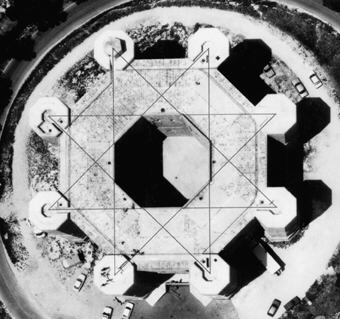
| Friedrich II and the Love of Geometry |
|---|
Springer Verlag, Heidelberg, Germany
 The Castel del Monte was built in the northern
part of Apulia by the Holy Roman Emperor Friedrich II of Hohenstaufen
in the last decade of his life. Its form is unique--an eight-sided
central structure with octagonal towers at each corner. The planimetric
aerial photo shows that the tangents of the octagon
forming the inner courtyard intersect at the centers of the octagonal
corner towers: they form an eight-pointed star whose tips lie
at the centers of the towers. Eight-pointed stars may also be
drawn around the corner towers. The close geometric connections
between the 8 stars thus created provide evidence that the size
of the towers was not chosen arbitrarily, but follows a precise
geometrical system. The geometric design of Castel del Monte
is an example of a configuration with an inner aesthetic. The
repetition of the basic 8-pointed star can be continued and,
as Max Koecher observed, results in a fractal with infinite iteration
possibilities.
The Castel del Monte was built in the northern
part of Apulia by the Holy Roman Emperor Friedrich II of Hohenstaufen
in the last decade of his life. Its form is unique--an eight-sided
central structure with octagonal towers at each corner. The planimetric
aerial photo shows that the tangents of the octagon
forming the inner courtyard intersect at the centers of the octagonal
corner towers: they form an eight-pointed star whose tips lie
at the centers of the towers. Eight-pointed stars may also be
drawn around the corner towers. The close geometric connections
between the 8 stars thus created provide evidence that the size
of the towers was not chosen arbitrarily, but follows a precise
geometrical system. The geometric design of Castel del Monte
is an example of a configuration with an inner aesthetic. The
repetition of the basic 8-pointed star can be continued and,
as Max Koecher observed, results in a fractal with infinite iteration
possibilities.
The two-dimensional layout of Castel del Monte can be identified as a symmetry group with 16 elements: 8 reflection planes and 8 rotations planes. The multiplicity of symmetries is expanded by homotheties among the large octagon of the main building, the octagon of the inner courtyard, and the eight octagonal towers placed in the same system of axes. The architect of the Castel del Monte was clearly aware of the aesthetic importance of symmetries, and used them to achieve the impressive appearance of the castle.
There are no written records concerning the history of the design of the castle, and we do not know who the architects were, but we may depend on the geometric configuration and its inner aesthetic to learn something about its creation. Navigational charts and wind stars provide an important clue. One such chart is the Carta Pisana, drawn at the end of the thirteenth century. an interesting depiction of an octagonal compass that exactly matches the shape of the layout of the Castel del Monte. A mosaic of similar form in the Alhambra exhibits an additional step in the development of the 8-pointed star figure.
Thus, Castel del Monte, with its extraordinary aesthetic radiance, stands at the crossroads of the Arabic-geometric and Middle-European-Gothic worlds, and represents the ruling spirit of one of the most important emperors of the middle ages.
|
Heinz Götze, "Friedrich II and the Love of Geometry", pp. 67-79 in Nexus: Architecture and Mathematics, ed. Kim Williams, Fucecchio (Florence): Edizioni dell'Erba, 1996. http://www.nexusjournal.com/conferences/N1996-Gotze.html |
|
|
|
|
